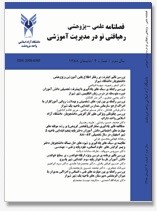طراحی الگوی ساختاری تفسیری موانع توانمند سازی منابع انسانی در وزارت ورزش و جوانان
محورهای موضوعی : آموزش و پرورش
سمیه عمادی
1
*
,
ابوذر زارع
2
,
مهدی رستگاری
3
![]() ,
ظهراب گوهری
4
,
ظهراب گوهری
4
1 - استادیار گروه مدیریت ورزشی، واحد داریون، دانشگاه آزاد اسلامی، داریون، ایران
2 - مدرس ذانشگاه فرهنگیان و دبیر تربیت بدنی آموزش و پرورش استان فارس
3 - استادیار گروه مدیریت ورزشی، واحد فیروزآباد، مرکز میمند، دانشگاه آزاد اسلامی، فیروزآباد، ایران
4 - دکتری مدیریت ورزشی، دبیر تربیت بدنی آموزش و پرورش استان فارس
کلید واژه: توانمندسازی, منابع انسانی, وزارت ورزش و جوانان, ساختاری تفسیری,
چکیده مقاله :
مقدمه و هدف: هدف تحقیق، طراحی الگوی ساختاری تفسیری موانع توانمند سازی منابع انسانی در وزارت ورزش و جوانان بود.
روش شناسی پژوهش: تحقیق حاضر از نوع تحقیقات کاربردی است که به صورت میدانی و به روش تحقیق آمیخته (کیفی و کمی) انجام شد. جامعه آماری در بخش کمی، شامل مدیران و کارشناسان حوزه منابع انسانی وزارت ورزش و جوانان و مدیران کل استان ها، برابر با 65 نفر و در بخش کیفی 18 نفر از خبرگان بودند. به دلیل محدودیت اعضا، جامعه آماری با نمونه برابر شد. ابزار تحقیق پرسشنامه ای محقق ساخته، حاوی 16 مانع توانمندسازی منابع انسانی وزارت ورزش و جوانان بود که روایی آن به دست 7 تن از استادان مدیریت ورزشی دانشگاه و پایایی آن با استفاده از محاسبه آلفای کرونباخ مورد تایید قرار گرفت (82/0=α). برای ساختاردهی موانع از تکنیک ساختاری تفسیری استفاده شد.
یافته ها: نتایج نشان داد که 16 مانع اساسی در مسیر توانمندسازی کارکنان وزارت ورزش و جوانان وجود دارد و این موانع در هشت سطح قرار گرفتند. موانع مشارکت ضعیف واحدهای عملیاتی، عدم وجود قوانین شفاف در خصوص توانمند سازی و کم توجهی به ارتقا و ابعاد توانمندی در نظام پاداش و تشویق در سطح زیربنایی قرار گرفتند.
بحث و نتیجه گیری: شفاف سازی در آیین نامه های تواناسازی کارکنان و تحکیم نظام پاداش و تشویق و همچنین مشارکت فعال واحدهای عملیاتی در کارگاه های آموزشی توانمندسازی منابع انسانی در اولویتهای تصمیم و اقدام قرار دارند.
Introduction: The aim of the research was to design an interpretive structural model of human resources empowerment obstacles in the Ministry of Sports and Youth.
research methodology: The current research is a type of applied research that was conducted in the field using a mixed research method (qualitative and quantitative). The statistical population in the quantitative section, including managers and experts in the field of human resources of the Ministry of Sports and Youth and general managers of the provinces, was equal to 65 people, and in the qualitative section, 18 people were experts. Due to the limitation of members, the statistical population was equal to the sample. The research tool was a researcher-made questionnaire containing 16 barriers to empowering human resources of the Ministry of Sports and Youth, whose validity was confirmed by 7 sports management professors of the university and its reliability was confirmed by calculating Cronbach's alpha (α=0.82). Interpretive structural technique was used to structure the obstacles.
Findings: The results showed that there are 16 basic obstacles in the way of empowering the employees of the Ministry of Sports and Youth, and these obstacles were placed in eight levels. Obstacles of weak participation of operational units, lack of clear rules regarding empowerment and lack of attention to promotion and dimensions of empowerment in reward and encouragement system were placed at the basic level.
Conclusion: It can be said that clarifying the employee empowerment regulations and strengthening the reward and encouragement system, as well as the active participation of operational units in human resource empowerment training workshops, are among the priorities of decision and action.

